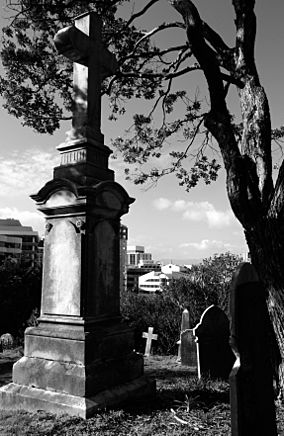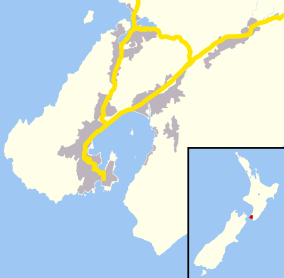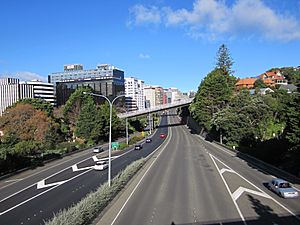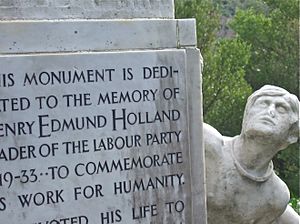Bolton Street Memorial Park facts for kids
Quick facts for kids Bolton Street Memorial Park |
|
|---|---|

View of the cemetery in Bolton Street Memorial Park, with central city high-rises in the background
|
|
| Location | Wellington |
| Nearest city | Wellington, New Zealand |
| Area | 18 acres (7.3 ha) including area acquired for motorway through the park |
| Established | 1840 as a cemetery and later converted to park |
| Governing body | New Parks and Recreation Department of the Wellington City Council |
Bolton Street Memorial Park, once called Bolton Street Cemetery, is the oldest cemetery in Wellington, New Zealand. It started in 1840. Many important people are buried here. The park is in the Thorndon area of Wellington. The Wellington City Council has a special trail, number five, that goes through the park. This trail visits famous graves, interesting spots, viewpoints, and old buildings.
History of the Park
The park's story is really the story of the people buried there. Many early settlers, known as pioneers, rest in this old Victorian-style cemetery. It opened in 1840 on the edge of the new town of Wellington. Different areas were set aside for Anglicans, Jews, and Roman Catholics. Important town figures, like William Wakefield, Wellington's founder, were buried here. The cemetery stopped new burials in 1892. This was because the city was growing, and there wasn't enough space. Only family members could be buried there after that.
In 1960, the city planned to build a motorway. Part of this road would go through the cemetery. Seven years later, the city council approved building the motorway. Because of this, the cemetery was closed for burials from 1967 to 1971. The historic cemetery was split in two by the new Wellington Urban Motorway. This caused a lot of debate at the time. The new motorway opened in 1978. That same year, the Wellington City Council Parks renamed the cemetery Bolton Street Memorial Park.
A group called "Friends of Bolton Street" protested moving the graves. They could not stop the road from being built. But they did make sure the cemetery got a special heritage status. The park also became a protected reserve. About 3,700 graves were dug up and moved. Most of these people were re-buried in a large underground vault under the park's lawn.
A footbridge now connects the parts of the cemetery that were moved. You can see headstones on both sides of the motorway. Around 8,500 people are said to be buried in the park. But only 1,334 headstones could be found. Most are made of marble or local stone, and 35 are made of wood.
A historian named Margaret Alington wrote a book about the cemetery. It is called Unquiet Earth: a History of the Bolton Street Cemetery. It was published in 1978.
Park Grounds
The park was originally about 18 acres in size. It was divided into different sections. About 7 acres were used by the Church of England. A smaller part was for Jewish burials. About 8 acres were for the public cemetery. The motorway now takes up about 3.7 acres of the park. It also took over about 4.5 acres of wooded burial ground.
Some land was also given up for other projects nearby. The park today is about 1.85 hectares in size. It also includes land given by Morva Williams.
You can get to the park from Bolton Street. There is also a path from Bowen Street and from the Botanic Garden. This path is right after Anderson Park. The park has walkways on both sides of the motorway. Signs along the paths share facts about Wellington's early history. The trails are popular with people who like to jog. The Upper Trail is quite steep. The Lower Trail has steps in some places. Tutaenui creek flows through a valley in the park. Bolton Street Memorial Park is now a historic reserve. It is managed by the Parks and Recreation Department of the Wellington City Council.
Buildings in the Park
Three buildings were first built in the cemetery area. Only one of them is still standing. This is the Church of England's Sexton's Cottage. A sexton was a person who looked after the church and cemetery. This historic timber building was built in 1857. It was made bigger in 1885 and is now being restored.
The public cemetery also had a Sexton's Cottage. It was also built of timber in 1857. The sexton David Robertson and his family lived there. This building was taken down in 1908. You can still see its brick outlines on the upper lawn.
The Mortuary Chapel was built of timber in 1866. It was left to fall apart and was finally taken down in 1969. This was to make way for the motorway. A new chapel was built that looks just like the old one. It is now the visitor centre. This replica chapel is in the smaller part of the cemetery. It has displays about the park's history. You can also find details about the people buried there. The "Friends of Bolton Street Memorial Park" group helps with information about the park's beehives.
Plants in the Park
The park is like an extension of the Wellington Botanic Garden. It has open grassy areas and rolling hills. These areas are covered with native plants growing back. There are also many different kinds of trees, shrubs, and flowers from other countries. A special collection of old-fashioned roses grows among the graves.
The park's collection of heritage roses is very important to New Zealand. When land was set aside for the public cemetery in 1840, early settlers planted roses. Later, the Wellington Botanic Garden added more roses. They worked with Heritage Roses New Zealand Inc. The rose garden is now looked after by the Wellington Botanic Garden.
Some of the "memorial roses" found in the park include Rosa banksiae 'Lutea' and Rosa indica major. Other types are 'Félicité et Perpétue' and 'Souvenir de la Malmaison'. These roses were planted by people visiting graves. Some were gifts from the public or members of the Wellington Heritage Rose Society. Others came from Europe through a seed exchange program. The park now has 210 heritage roses. Important types include 'Archduke Joseph', 'Mutabilis', and 'Old Blush China'.
Notable Burials
Many important people from New Zealand's history are buried or were once buried here.
Graves still existing:
- William Beetham (1809–1888): A respected portrait painter. He started the New Zealand Academy of Fine Arts in 1882.
- Henry Blundell (1813–1878): A newspaper owner. He founded The Evening Post newspaper.
- James FitzGerald (circa 1818 – 1896): An important politician in the 1800s.
- Harry Holland (1868–1933): He was the leader of the New Zealand Labour Party.
- Kennedy Macdonald (1847–1914): A Member of Parliament in the 1800s. His grave has an angel statue. It remembers his three sons who died from scarlet fever in one month in 1876.
- Samuel Duncan Parnell (1810–1890): He is known for helping to create the Eight-hour day in New Zealand.
- John Plimmer (1812–1905): A successful business person. He is sometimes called "the Father of Wellington."
- William Barnard Rhodes (1807?–1878): A businessman, farmer, and politician. He was one of the richest people in New Zealand when he died.
- Richard Seddon (1845–1906): He was the longest-serving Prime Minister of New Zealand (from 1893 to 1906). He was the first to give women the right to vote and start old-age pensions.
- Christian Toxward (1831–1891): A Wellington architect.
- Edward Gibbon Wakefield (1796–1862) and William Wakefield (1801– 1848): Brothers who were very involved in setting up New Zealand as a colony.
- Jonas Woodward (1810?–1881): A businessman, educator, politician, and public trustee.
Monument reinstated after being moved for the motorway:
- Alexander Turnbull (1868–1918): A New Zealand merchant and book collector.
Graves moved for motorway construction:
- Alfred Ludlam (1810–1877): A leading New Zealand politician, gardener, farmer, and a founder of Wellington's Botanic Garden.
- George Macfarlan (1837/38–1868): A Member of Parliament for the Lyttelton area.







